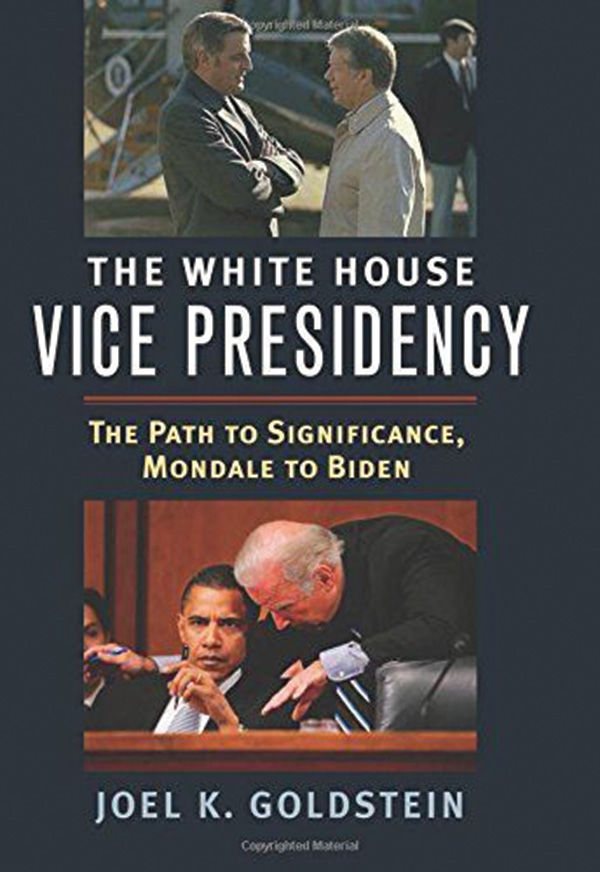Scholar’s latest book confirms his expertise on vice presidency
Published July 13, 2016
As this book review is being written, both of the presumptive major party presidential nominees—Democrat Hillary Clinton and Republican Donald Trump — are reportedly vetting a number of candidates to be their running mates. Once again, Joel K. Goldstein has become the go-to scholar on the Office of Vice President of the United States, a status that is confirmed with the publication of his latest book, “The White House Vice Presidency: The Path to Significance, Mondale to Biden.”
Goldstein, the Vincent C. Immel Professor of Law Faculty at St. Louis University, had already established his solid credentials as a leading expert on the second highest elective office in the land. In 1982 his book, “The Modern American Vice Presidency: The Transformation of a Political Institution” was published.
A past president of the Jewish Community Relations Council of St. Louis, Goldstein earned a Ph.D. in politics from Oxford University, where he was a Rhodes Scholar. He also earned a doctor of law degree from Harvard Law School in 1981.
ADVERTISEMENT
Both of Goldstein’s books should be read in tandem. They present a detailed and colorful history of how the Office of Vice President evolved from being maligned as involving “presiding over the Senate and waiting for the president to die,” to a position of tremendous importance.
In his 1982 volume, Goldstein says the modern vice presidency can be traced to April 12, 1945, when Harry S Truman was thrust into the presidency on the death of President Franklin D. Roosevelt. Little was expected at first from the Man from Missouri, who had gone broke as a haberdasher in Kansas City and who was considered a tool of the Pendergast political machine in that city.
Truman in retrospect is now regarded among the near-great American presidents in several rankings by prominent historians. On his watch, the decision was finalized to bomb Hiroshima and Nagasaki. Truman also resisted pressure from his own State Department and went ahead with the recognition of the State of Israel 11 minutes after it was founded.
ADVERTISEMENT
Goldstein argues that another important milestone for the vice presidency began with that of Walter Mondale, Jimmy Carter’s vice president for his one term in office. Carter broke the mold of the traditional presidential approach to his running mate.
To be sure, Mondale, a former liberal Democratic Senator from Minnesota, was a sound geographic “ticket-balancer” to the President from Plains, Ga. But once in office, Carter did not relegate Mondale to the traditional “invisible person” status of many of his predecessors.
Goldstein describes how Carter established a new model for the office in which the president could make full and meaningful use of his highly intelligent running mate. Mondale became a close confidant of Carter and his representative on key foreign trips of consequence—not only funerals of foreign dignitaries, but meetings of substance and consequence.
Of interest to Jewish readers is Goldstein’s description of Democrat vice president Al Gore’s selection of the centrist Sen. Joseph Lieberman from Connecticut, a practicing Modern Orthodox Jew, as his running mate in 2000 in the hard-fought election against Republican George W. Bush and his running mate Dick Cheney.
No Jew had ever received a major party nomination for either president or vice president until Gore tapped Lieberman.
“Presidential candidates hope their vice-presidential pick will boost their campaign by confirming their decision-making ability,” writes Goldstein. He lists Gore’s choice of Lieberman among other selections “which were judged overwhelmingly to reflect well on the selectors,” in contrast to others, such as George H. W. Bush’s selection of the unknown and untested Dan Quayle, which drew widespread scorn and ridicule.
Goldstein adds that in surveys taken shortly after the vice-presidential choice is announced, 60 percent of registered voters say the running mate will influence them, generally in a positive direction.
He concludes on an upbeat assessment: “White House vice presidents, like others, have made mistakes, sometimes serious ones. Yet the institution Carter and Mondale created and their successors developed has enhanced American government. Its creation and endurance should inspire hope in the possibility of institutional evolution and regeneration and of constructive political leadership, and its example provides lessons for others to apply.”
As the “Veep-stakes” heat up in the run-up to the major party national conventions, it is certain that Goldstein will again be busy as the “go-to” scholar on the office, and that his books will be the definitive references on the topic for years to come.

















